The Ultimate Guide to Building an Audience in the Creator Economy
It's easier than ever to start a project on the internet, but building an audience for it is harder than ever. Wherever there's opportunity there's competition.
- Millions of aspiring creators are trying to build an audience for their work
- Platforms are saturated
- Lower Barriers to Entry Raise the Bar
Unless you're so good they can't ignore you, everyone will. Standing out in a sea of noise is no longer just a matter of success. It's a matter of survival.
Bad advice in self-help books, commencement speeches and TED talks leads to delusional optimism and reckless decisions.
People who give this advice benefit more than those who follow it.
Skilled Marketers Can Manufacture the Illusion of Success and Credibility
It doesn't take much to alter public perception to make people believe someone is successful when they're not.
- Design a beautiful web site
- List a few prominent media outlets to enhance your credibility
- Claim you're a best-selling author in some obscure category on Amazon.
- Spend enough money on ads to buy a million followers
If enough people collectively agree that someone is successful, people never don't even bother to verify it it's true.
Why I Wrote This Guide
I started 5 blogs, most of which lingered in obscurity. After I graduated from business school, I started a blog titled 100 Reasons You Should Hire Me. Not only did nobody read it, I couldn't come up with 100 reason for someone to hire me.
After months of throwing spaghetti against the wall, I enrolled in an online course, which gave me a structure and strategy for starting a blog, and acquiring readers. While the course was incredibly helpful, it took me another 10 years to build the fundamental skills every creator needs.
Most advice on the internet about building an audience is inaccurate, irrelevant, ineffective and complete bullshit.
- People support their claims with Anecdotal Evidence
- They don't context into consideration when they give advice
- Every hack, strategy and list of tips eventually becomes obsolete
Aspiring creators waste a lot of time because of this advice. The process of growing an audience for a creative endeavor is not about SEO, content marketing, social media, the right marketing strategy, or having the best content. It's about human psychology. Content is a vehicle for transformation.
Are you too busy to read the whole guide right now?
No worries. Just click on the link below and I'll send you a PDF version, which you can read at your convenience.
What You'll Learn
Part 1: The Foundations for Sustained Excellence
There are three foundations of excellence, all which apply regardless of your domain.
- Innate Ability
- Choosing A Domain With a High Probability of Success
- Commitment to Mastery
You need to lay the foundation before you build a house.. In the same way you lay the foundation for building a house, you need to lay the foundations of excellence for building an audience.
Part 2: The 3 Biggest Myths About Building An Audience
There are three big myths that about building an audience that cause creators to waste a lot of time.
- The Influencer Myth
- The Myth of Virality
- The Myth of Stickiness
When you understand what these myths are and how they work, you'll realize that
- Influencers aren't as influential as we think.
- Rules of social influence play a huge role.
- Small Groups on the Periphery of Networks are more influential you realize.
These 3 big myths will help you understand how ideas spread and audiences grow.
Part 3: Developing the Habits of a Creative Professional
The way you work will have a massive impact on your ability to build an audience. When you make the transition from amateur to professional, you'll see
- Nobody Gives a Shit What You Start
- Habits are the compound interest of creative success
- Deep work Creates Real Value, Shallow Work Doesn't
- Systems, rituals, and routines are essential
Unless you develop the working habits of a creative professional, you'll have a difficult time building an audience.
Part 4: Building an Audience in the Creator Economy
To build an audience in the creator economy, you have to understand
- The Landscape of the Creator Economy
- 3 Pillars of great content
- How to Adapt to technological paradigm shifts
Otherwise, you'll become a cautionary tale of the creator economy.
Everybody Should... The Ultimate Form of Bullshit
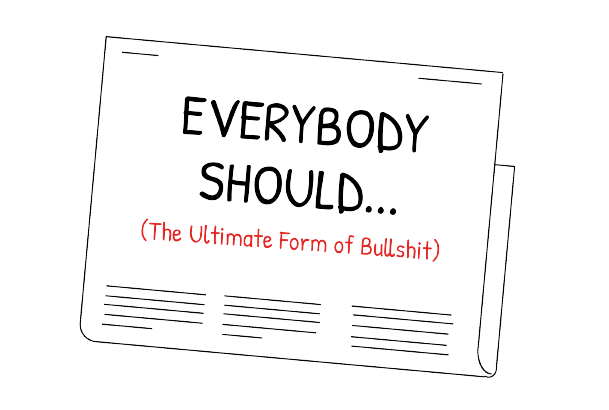
Start a podcast, build a blog, write a book, be a public speaker, or become an entrepreneur.
Anytime you see the words "everybody should" in EVERYTHING you read, hear, or watch, assume what follows is bullshit.
As you parents probably said when you were a kid "if all your friends were jumping off a bridge would you?"
Because of social media, in the past 10 years, motivational speakers, podcasters, bloggers, and authors of self help books have perpetuated false delusional narratives that cause people to follow their passion into poverty, make reckless decisions, and forget that outliers are bad role models for most of us.
The Internet, social media, smartphones-we are exposed to increasingly sophisticated ways of diverting our attention. We become addicted to connectivity, to meaningless checking, to a life of fragmented attention across myriad streams of digital information. In short, the algorithms driving social media content are bullshitters.
-Calling Bullshit, Carl Bergstrom
Anytime you see the words "everybody should" in EVERYTHING you read, hear, or watch, assume what follows is bullshit.
Variables You Can't Replicate
It's useful to reverse engineer someone's path to success. But hidden variables make it impossible to follow in their exact footsteps and get the same results. The most obvious one is that you are not that person.
I started the Unmistakable Creative 10 years before podcasts became a massive cultural trend. If you tried to reverse engineer my path, you'd discover numerous variables you couldn't replicate
- An amazing mentor who I met on twitter
- A freakish coincidence that got my self published book on Glen Beck's radar
- An editor who stumbled on an article I wrote on medium.
I was the beneficiary of luck and timing. You'd be an idiot if you tried to reverse engineer my path.
Private Interest
If you want to avoid wasting time and money, ask yourself the following three questions anytime you come across prescriptive advice.
- Who is the source?
- How do they Know?
- What are they trying to sell?
For example, a famous podcaster might say everyone should start a podcast.
- This podcaster has 100,000 subscribers on his email list
- He also sells a course on how to start a podcast
Unless you have 100,000 subscribers won't get the same results. Anytime a person who gives you advice benefits from it financially, you have Douglas Vigliotti calls a private interest problem. For the person who sells a course on starting a podcast, it's their best interest to tell you should start one, especially if you buy their course.
Great Advice in the Context of One Person's Life is Bullshit in The Context of Another's
Benjamin Hardy (who is a friend and former podcast guest) is one of the top writer's on Medium. When he published the article 8 things everybody should do before 8am, it went viral, received 50 million views, and led to a book deal with a publisher.
With all due respect to Ben, if you've just finished a 13 hour shift at a hospital, none of his advice makes sense. The only thing you should do is get some damn sleep.
Productivity hacks that work for a single rich white guy are useless for a mother raising three little kids. If Tim Ferriss had to babysit his listeners kids for a week, his best productivity strategies would be useless.
The same is true for other prescriptive advice. All advice is contextual (including mine).
Part 1: The Foundations for Sustained Excellence

1. Genetics and Innate Ability

The belief that you can do anything you put your mind to doesn't make you an optimist. It makes you an idiot. A few years ago, an ambitious college student posted the following question on quora. How can I be great like Steve Jobs, Richard Branson, and Elon Musk? He got a response from an unlikely source.
Justine Musk understands the psychology of visionaries better than most people because she's had a front-row seat to it.
Very few people are wired for extreme success. You're probably not going to be the next Steve Jobs, Oprah or Beyonce. But that doesn't mean something is wrong with you.
We all have genetic limitations which determine our innate abilities. When we don't acknowledge our genetic limitations, we lie to ourselves and overlook our innate abilities.
50% of What it Takes is Genetic
Your odds of becoming an NBA Superstar are much higher if your father is an NBA basketball player and mother is an olympic sprinter. If you're the scrawny Indian son of a college professor like me, there's a snowball's chance in hell you'll make it to the NBA.
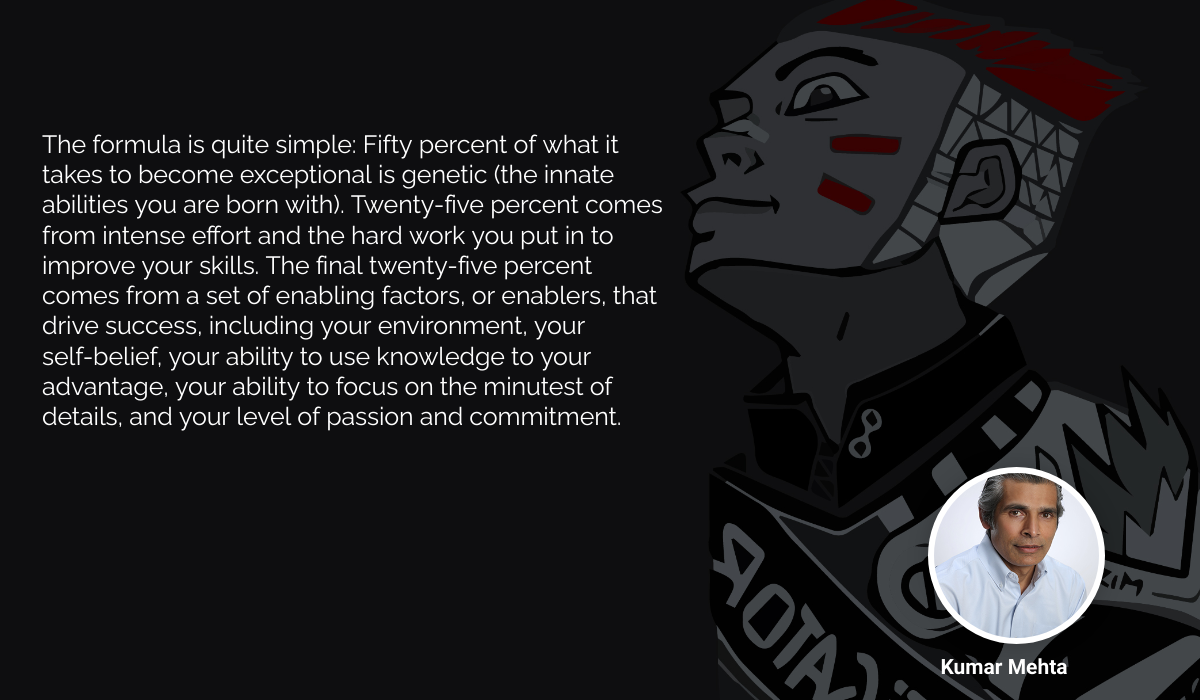
People who read and write self help books hate the idea of genetic determinism. But it doesn't matter how many books you read or motivational seminars your attend.
Everyone is born with strengths and weaknesses. Acknowledge your genetic limitations and double down on your strengths2. Choose the Right Domain for Sustained Excellence

The first lesson to realize is that to become exceptional , you need to start in a domain where you have a natural strength, whatever it may be. With the right amount of effort, you can become good at just about anything, but trying to become exceptional in a field where you don't have a natural ability is simply an exercise in futility. We all have a talent or a gift; you just need to honestly determine what it is. -Kumar Mehta, The Exceptionals: How the best Become the Best and You Can Too
Bill Gates couldn't have led the Lakers to an NBA championship. In the wrong domain for sustained excellence, a genius is an idiot. But in the right one, geniuses become exceptional in their fields.
Start with Your Natural Strengths
I started a podcast because my first business partner Sid Savara said I was an average writer, but a great interviewer. Conducting interviews was a natural strength, writing was not. If I hadn't been open to his feedback, my blog would have been yet another creative project buried in the digital graveyard of the internet.
To increase your odds of choosing the right domain for sustained excellence, start with your natural strengths.
Match Aptitude with Activity
When employees underperform, organizations use performance improvements plans. But these plans do more to prevent wrongful termination lawsuits than they do to improve performance.
Whether you're building an audience or trying to perform better at work, you need to match aptitude with activity.
- It doesn't make any sense for a brilliant introverted visual artist to start a podcast.
- If you're an amazing an amazing writer but suck in front of a camera, don't start a youtube channel.
When you match aptitude with activity, you end up in your zone of genius. When you don't, you end up in your zone of mediocrity.
When you match aptitude with activity, you end up in your zone of genius. When you don't, you end up in your zone of mediocrity.
Balance What's Possible with What's Probable
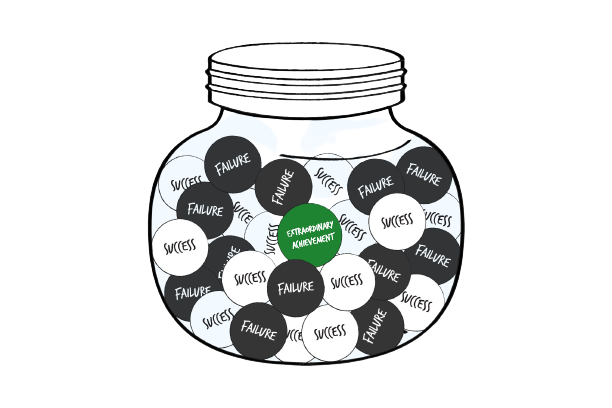
Delusional optimists only focus on what's possible. Rational optimists also consider what's probable. If you chose the right domain and match aptitude with activity, you can increase your odds of becoming exceptional in your chosen field.
Sam Altman says if you want to find a co-founder rich environment, go work at a successful company before you start a startup.
- First, you'll learn what makes a company successful.
- Second, you'll be exposed to people who have more experience
- Third, you'll have opportunities to learn, and build on your natural strengths.
It's not a coincidence that Chris Sacca, Kevin Systrom and some of the most successful startup founders in Silicon Valley are Google Alumni.
Consistent and Intense Effort
You can from idea to execution faster than any time in history. But the path from mediocrity to mastery is lifelong journey. While the relationship between effort and reward isn't linear, you'll have to exert consistent and intense effort to accomplish your goal.
Excellence When it Matters Least
Moments in the spotlight are few and far between.
- Writers spend 2 years writing a book that people read for 2 days.
- Actors spend 100's of days on a set to film a movie that people will watch for 2 hours.
Moments in the spotlight are the result of what you do when you're not. How you practice is how you perform. While you're dreaming of seeing your name in shining lights or on the cover of a book, someone else is doing the work that will make those things a reality.
Success is a Process, Not a Result
The intense effort required to do anything extraordinary is a marathon, not a sprint. It's the result of countless small steps . You can't build a successful career in the arts by being a one hit wonder.
- Seth Godin couldn't have written 17 best-selling books without publishing a blog post every day
- Kobe Bryant wouldn't have become one of the greatest basketball players of all time without practicing every day.
The story of every successful writer, blogger, podcaster, or "overnight sensation" who succeeded with building an audience is years in the making. Success is a process, not a result
Are you too busy to read the whole guide right now?
No worries. Just click on the link below and I'll send you a PDF version, which you can read at your convenience.
3. Enablers: Geography and Self Belief
![Illustrations for Ultimate Guide to Building an Audience [36855]-05](https://unmistakablecreative.com/wp-content/uploads/2021/10/Illustrations-for-Ultimate-Guide-to-Building-an-Audience-36855-05-scaled.jpg)
Your Geographical Environment
Opportunity might be distributed equally, but access to it is not. Geography determines what resources are available to you, such as school curriculum, teachers, opportunities to develop your skills, and talent clusters.
To excel at anything, the first and most obvious need is to have unfettered access to the resources necessary-facilities, people. ideas-to make you successful. At the most basic level, if you want to become an exceptional skier, you need to have easy access to snow; if you're going to find the cure for a rare you need ready access to a well-equipped lab.
Kumar Mehta
In other words, where you live plays a significant role in what you can accomplish.
High School Music Programs in Texas
Texas arguably has the best high school music programs in the country.
- First, music education is mandatory. Between 6th and 8th grade, every student must participate in choir, band, or orchestra.
- Second, competition breeds commitment to excellence and intense effort.
School districts are broken down into regions (a combination of high schools in multiple districts) and areas (a combination of high schools in multiple regions). To make all-state band, choir or orchestra, students must be the top musicians in their regions and in their areas. As a result, high school music programs in Texas are breeding grounds for world class musicians.
When I lived in Texas, I missed all-state band by one chair as a freshman. After my parents moved to California, I was first chair in all-state band because of access to the resources I had in Texas.
Without access to the right resources for sustained excellence, it's hard to become exceptional at anything.
Talent Clusters
Because of the geometry of social networks, wide bridges create strong ties . What is a wide bridge?
It involves a group of people from one division engaging with teams from another through multiple overlapping connections. Wide bridges are not about reach but redundancy. They allow people on both sides of the bridge to hear the opinions and recommendations of multiple peers and colleagues and to discuss and debate ideas with them. Wide bridges mean stronger ties. - Damon Centola, Change: How to Make Big Things Happen
In talent clusters, it's much easier to build a contagion infrastructure that enables the transfer of knowledge. It's why successful filmmakers come from Hollywood, and successful startup founders come from silicon valley.
Social Surroundings
If all of your friends in high school were straight A-students, you're more likely to be one. The same is true for athletics, music, or any other domain in which people achieve excellence.
Your social surroundings play a critical role in how you develop extraordinary talent, Many of the exceptionals came from homes where discipline was valued, as was the need to work hard. Most important, they were steeped in a culture where high achievement and excellence were expected. People tend to rise to the level of the expectations placed on them and the level of skill they witness around them.
Kumar Mehta
Parents, peers, co-workers, and neighbors are the underlying architecture of your social environment. All three impact your attitudes, beliefs, and behaviors. In his book , Kumar Mehta cites 3 major pillars in the social environments of exceptional people.
1. The Expectation of High Achievement
Indian parents don't reward or praise their kids for high achievement. They expect it. It's why Indian kids win spelling bees, become valedictorians of their high schools, doctors, lawyers, engineers, and the CEOs of two of the most successful tech companies in the world are Indian.
Many of the most exceptional individuals grew up in an environment where there was an expectation, not just a desire of high achievement. Achieving excellence and trying their very best was the norm. The Exceptionals: How the best Become the Best and You Can Too
As critical as I've been about the Indian culture, the expectation of high achievement taught my sister and me the power of intrinsic motivation. There's no doubt in my mind this had a massive impact on my journey of building an audience.
What starts as an expectation of high achievement from others eventually becomes your expectation of yourself.
2. Work Ethic
When it comes to success, you see
- The founder who takes his company public
- An author who write a best-seller
- Actor who lands a leading role
You don't see the years of rejection, moments of insecurity, fear, and self-doubt. The parts of someone's journey you don't see are what Scott Belsky calls The Messy Middle. Your work ethic will determine whether you get through the messy middle or don't.
3. Self Belief
In his book, How to Get Rich, Felix Dennis said that "self-belief is a priceless asset." And it's vital for building an audience.
Specifically, self-efficacy is the belief that you can achieve a specific goal. This is important because it is the specificity that drives performance
Kumar Mehta
Self-efficacy leads to confidence, and Confidence Breeds Commitment. But even if you believe you can succeed at a wildly ambitious goal, don't set unrealistic goals. Two limiting beliefs prevent many creators from building an audience for their work.
1.Self Promotion is Bad
The internet is not the field of dreams. "If you build it, he will come" is an inspirational quote, not a strategy for building an audience.
- First, if you're not willing to promote your work, how can you expect anyone to find out about it?
- Second, if you don't believe what you've created is worth sharing, how can you expect anybody to think it's worth consuming?
Unless you're willing to promote your work, you'll linger in obscurity.
Unless you're willing to promote your work, you'll linger in obscurity.
2. It's Wrong to Get Paid for Your Work
Samantha Bennett says, "you're always getting paid in the currency you ask for." Ask for clicks and likes, and that's how people will pay you. But if you want to make a living as an artist, ask for money.
Real artists don't starve because they're unapologetic about asking people for money. Remember, you're running a business, not a charity.
Part 2: The 3 Biggest Myths about Building an Audience
![Illustrations for Ultimate Guide to Building an Audience [36855]-06](https://unmistakablecreative.com/wp-content/uploads/2021/10/Illustrations-for-Ultimate-Guide-to-Building-an-Audience-36855-06-scaled.jpg)
Consider the following scenario.
- Gary Vaynerchuk shares your latest blog post, podcast, or video with his followers
- Your content goes viral. You get millions of visitors to your blog or millions of viewers on your Youtube video.
- Thanks to Gary, you now have a massive audience.
While that may sound like a dream come true for any aspiring creator, it's not how ideas spread or audiences grow. According to Damon Centola, author of Change: How to Make Big Things Happen, there are three big myths about building an audience.
1. The Influencer Myth
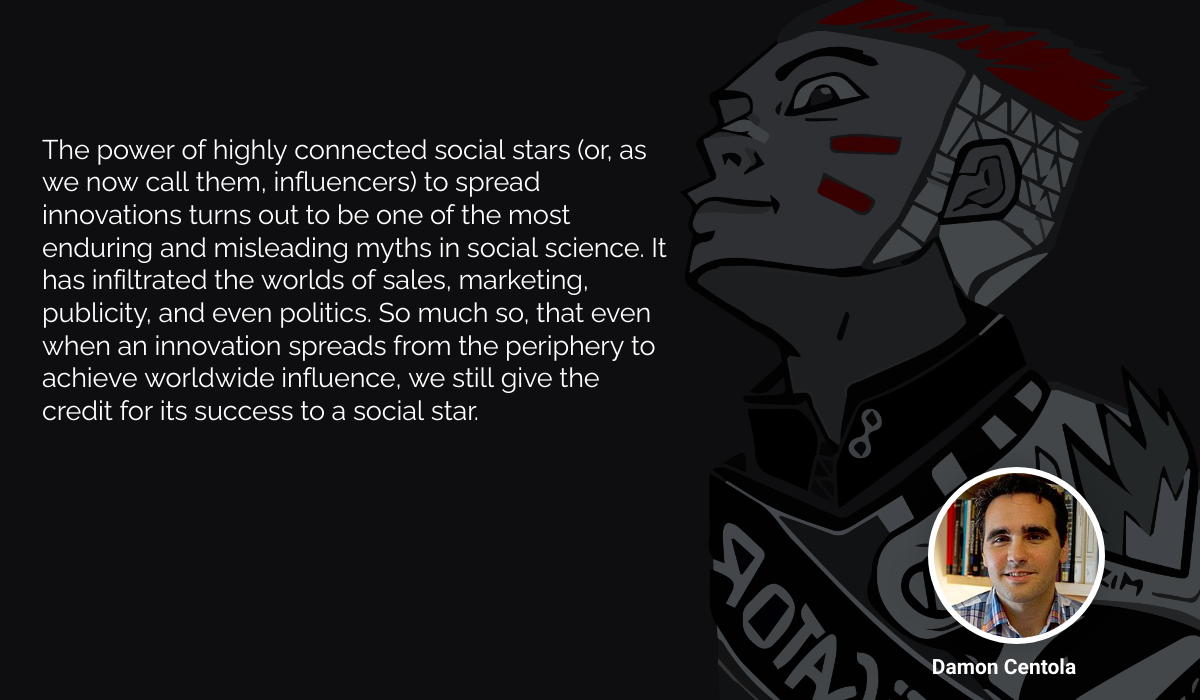
Like most podcasters, I thought by interviewing well-known bloggers, they would share my interviews with their followers, every interview would go viral, and I'd reach an audience of millions. That never happened.
Three months after I started The Unmistakable Creative Podcast, I realized that our listeners, not guests, were the key to growing our audience. Nothing reflects Damon's point more than this review from one of our listeners.
Status, fame, or reach do not influence how I choose my podcast guests. You probably know the names of dozens of people I've turned down for our podcast.
Influencers aren't as influential as we think.
As the media landscape becomes more fragmented, loyalty will be more valuable than reach. And it's much easier to build a loyal audience with people in small groups on the Periphery of Networks.
A small number of peer adopters would be much more influential for a more moderately connected person than they would for a highly connected CEO. Because people in the network periphery have fewer countervailing influences surrounding them, a few initial adopters constitute a far greater fraction of their social network. - Damon Centola, Change: How to Make Big Things Happen
Instead of begging influencers to share your content, focus on the people who are already consuming it. Build relationships with them. One fan for life will do more to grow your audience than thousands who pay attention for a moment.
Don't Judge a Person's Credibility Based on Perceived Status.
Just because someone has millions of followers or is famous on the internet doesn't mean they'll have a tangible impact on your life.
- My mentor Greg Hartle had 150 followers on Twitter when I met him. But nobody has had a more tangible impact on my life and career.
- Joseph Logan is practically invisible on social media. He was instrumental in helping me raise my first seed round
If you think people with millions of fans and followers are your ticket to success, you'll miss out on relationships that could have the most meaningful impact on your life or career.
You Have to Change Beliefs to Change behavior.
To create real change, you need to do more than spread information; you must change people's beliefs and behaviors. And those are much harder to influence. (source)
No human decision is void of emotion. Emotions determine almost every decision we make, from who we marry to the products we buy. To change people's beliefs, your work has to invoke an emotional response.
Exposure is not enough to create change.
Behavior Change Doesn't Work like a Virus. Most of us ignore most content that rolls through our newsfeeds because it's irrelevant or doesn't evoke an emotional response.
Innovative ideas and behaviors do not spread virally; simple exposure is not enough to "infect" you.-Damon Centola, Change: How to Make Big Things Happen
If your content sucks and an influencer shares it with a million people, it won't gain traction. In the long run, it will cause more harm than good. Instead of begging people to share your content with their audience, create something worth sharing.
Having followers doesn't make you an influencer.
Plenty of people on Facebook, Instagram, and Twitter have millions of followers. But they don't influence shit, and all they affect are vanity metrics that inflate their egos.
What makes you an influencer is changing the people who follow you somehow, and asking someone to consume your content is asking them to change their behavior. Thus, your work has to change beliefs if you want to build an audience for it.
Countervailing Forces
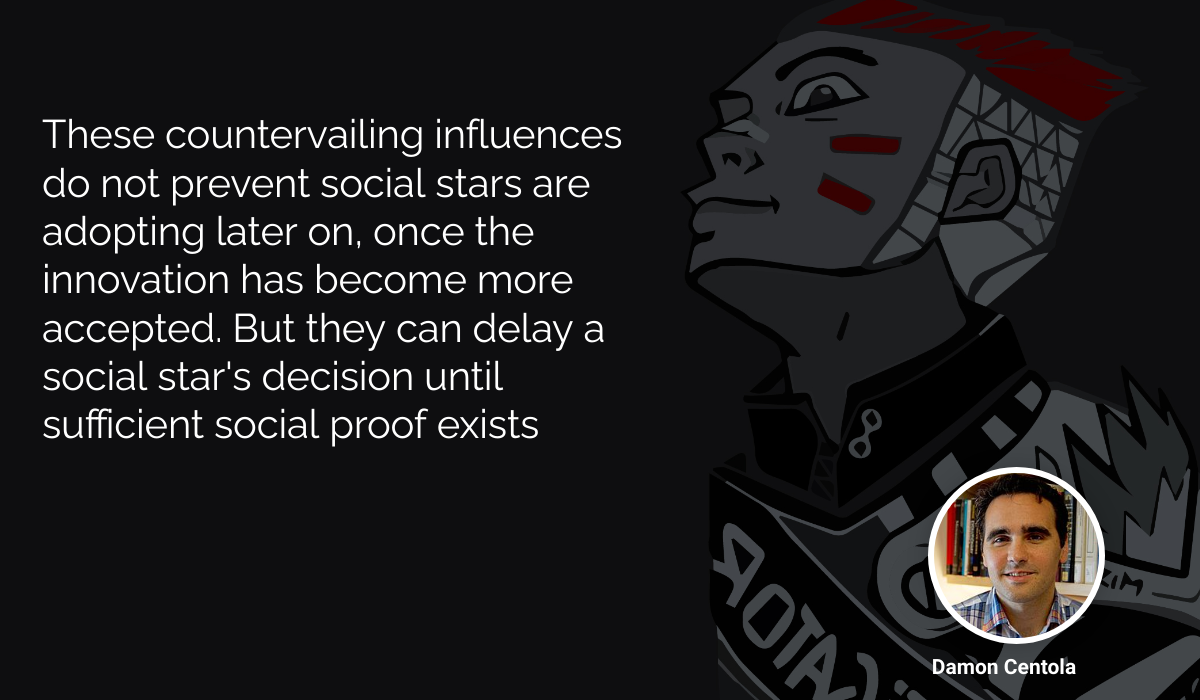
People with high status will be reluctant to adopt something new until other people do. Social status within a network plays an important role in the decisions that people make about what to promote, purchase and adopt.
When influential people share or recommend something, they put their reputation on the line with their audience and their peers. You have to increase your status within a social network to overcome these countervailing forces.
Climb the peer-status ladder
Social status within a network is something you earn through hard work, building relationships, and ultimately proving that you've accomplished something worthy of that status. Like any other system, social networks are interdependent, and nobody exists in isolation, and it's impossible to build an audience without meaningful relationships.
As your reputation for great work increases and you build what Cal Newport calls career capital, you'll climb the peer-status ladder.
Famous friends won't grow your audience
They become receptive to your work when you've already built one. When I started The Unmistakable Creative Podcast for bloggers, I interviewed relatively unknown up-and-coming bloggers.
- Sid Savara, my first business partner, was higher on the peer-status ladder. Because of him, I was able to land higher-profile guests.
- Ryan Holiday introduced me to my literary agent when I told him Penguin Portfolio was interested in my book. And both of them would be less receptive if I didn't have a potential book deal on the table.
That being said, as you climb this ladder, don't ignore Small Groups on the Periphery of Networks. Without them, you can't climb the first step on the peer status ladder.
Word mouth is how ideas spread and sustain, and it's how people who are higher on the peer-status ladder learn about you in the first place. If you're so good they can't ignore you, you'll eventually earn the respect of your peers and climb the peer-status ladder.
2. The Myth of Virality
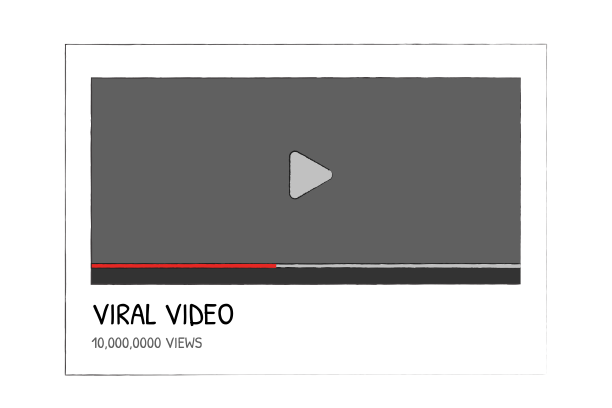
Do you remember any of the videos, articles, or pieces of content that went viral on the internet yesterday, last week, or last month? Today's viral sensation usually becomes an afterthought by tomorrow. That's because most content on the internet falls into two categories: simple and complex contagions.
The Dynamics of Simple Contagions
The problem is that the dynamics of simple contagions apply only to the spread of simple ideas. Beliefs-and-behavior change spreads in a different way and through different channels. Any change that involves real risk-financial, psychological, or reputational- requires more than simply coming into contact with a single random adopter or "carrier.
Damon Centola
Simple contagions have a short shelf-life
The paradox of viral content is that it eventually drowns in a sea of noise. What Ryan Holiday calls a Perennial Seller, on the other hand, has an infinite shelf life, and Ryan Holiday says, "Nothing can survive long term without word of mouth."
It stops spreading when people stop talking about a simple contagion like a viral video or blog post. If a million people read your blog, listen to your podcast, watch your video, or hear your music today, but none of them come back tomorrow, you might get their attention, but their commitment.
Over a long enough timeline, commitment scales, attention doesn't.
Behaviors We Care About Our Complex Contagions
Simple Contagions Spread Though Reach. But when it comes to complex contagions, exposure is not enough. If people don't believe they'll benefit from your content, they won't give a shit.
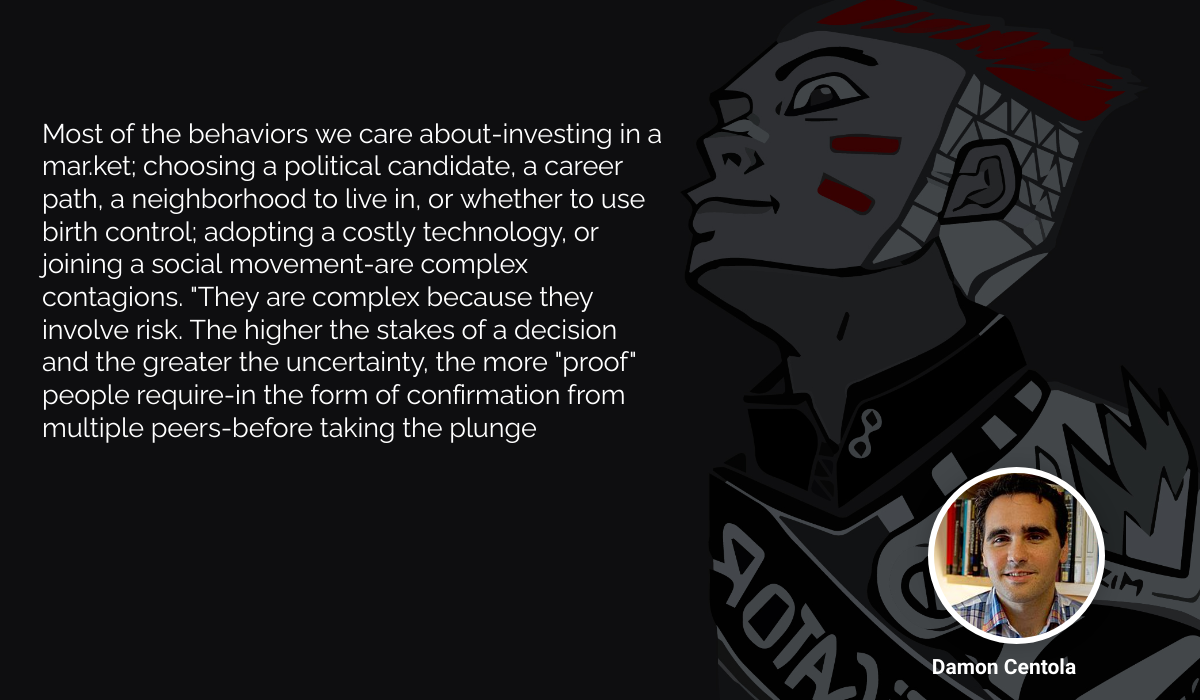
Asking people to risk investing their time, energy, money, or attention in your work is a complex contagion. Unless your content is a valuable resource, it won't mean much to people.
Don't confuse attention with commitment and Reach With Depth.
You can buy attention for your work if you're willing to spend enough money. When you earn someone's attention, you're more likely to earn their commitment. Regardless of how small your audience is treat them like the most important people in the world.
You can touch 10 hearts or reach a million eyeballs. As Austin Kleon says, you want hearts, not eyeballs.
Are you too busy to read the whole guide right now?
No worries. Just click on the link below and I'll send you a PDF version, which you can read at your convenience.
3. The Myth of Stickiness
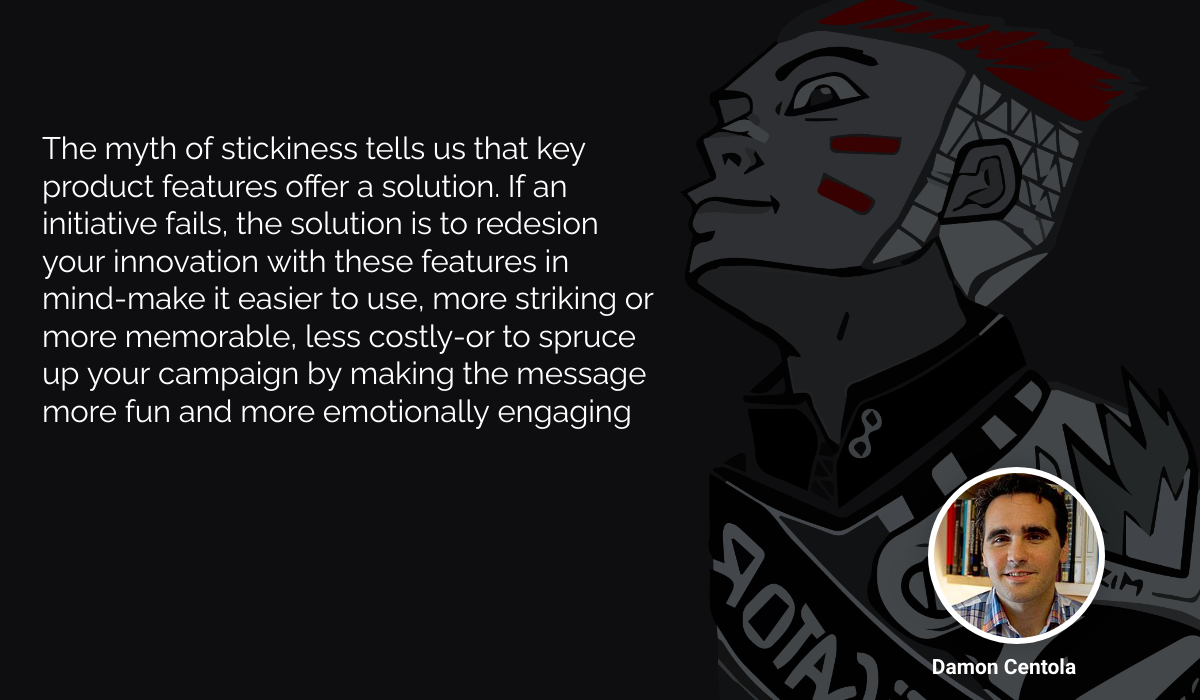
I'm an average writer who writes a lot. Many of you reading this are far better writers than I ever will be. The myth of stickiness causes many talented artists to linger in obscurity.
The quality of the work you do is essential, but it's only one part of the equation. There's only so much you can optimize, edit, and proofread your content.
Speed Trumps Perfection which means Sacrificing perfection for progress. Building an audience isn't only about the quality of your products or your work.
It's About Hype
People who make ideas spread are those who Michael Schein calls hype-artists. Every successful author, founder of a startup, and artist is a hype artist. To build an audience, sell a product, or grow a company, you have to create Hype.
Hype is the practice of generating an intense emotional reaction from a large number of people to achieve a specific outcome.
Michael Schein
People consume content first because of how it makes them feel. As a creator or artist who wants to build an audience, you need to elicit an emotional response from the people you want to reach.
Steve Jobs was a master hype artist
Apple has mastered the art of creating Hype like no other company in the world. When Apple launches a new product, they create anticipation and excitement that gets people standing in line overnight to get their hands on it. It's impossible to ignore the press a new product launch generates for Apple. Just do a Google search for "iPhone 13."
As the Apple store employee joked when I picked up my iPhone 13, "you're here for the Justin Bieber concert, right?" That's the kind of Hype that leads to building the most valuable company in the world.
When it comes to building an audience for their work, successful people are always creating happen in big and small ways.
- Every time a blogger sends his newsletter his latest blog post, he's creating Hype.
- When James Altucher's published his book, Choose Yourself, he hired Ryan Holiday to help with the book marketing. At the time, there were a lot of stories about bitcoin in the news. To take advantage of this, Ryan recommended suggested letting people pay him for the book with bitcoin. He created Hype by being the first author to let people buy his book with bitcoin.
- When an author appears on podcast after podcast and shares pictures of her book on Facebook and Instagram before a book launch, she creates Hype.
The difference between hype and bullshit artists is that the former creates something worthy of hype
Part 3: Develop the Working Habits of a Creative Professional

Amateurs thrive on what they want to hear, and professionals embrace what they need to hear. If you're serious about building an audience, you must develop a creative professional's working habits and mindset.
![Illustrations for Ultimate Guide to Building an Audience [36855]-10](https://unmistakablecreative.com/wp-content/uploads/2021/10/Illustrations-for-Ultimate-Guide-to-Building-an-Audience-36855-10.jpg)
1. Nobody Gives a Shit About...
The book you're planning to write.
The blog you're going to start.
TEDtalk you plan to give
The podcast you intend to launch.
Speculation is mental masturbation that doesn't even give you the pleasure of an orgasm.
When people congratulate you on social media with hearts, likes, and comments for things you intend to do, it creates a false sense of progress. You confuse attention with accomplishment before you've accomplished anything.
Stop talking about your work. Start Shipping It.
Ryan Holiday is one of the most prolific authors of his generation. But you'll never hear a word about his next book until he finishes writing it. He posts pictures about his latest book on Instagram only two times: when he submits his final manuscript and when the book is available to buy.
Stop waiting to be inspired and act in anticipation of inspiration
As the artists Chuck Close says, "motivation is for amateurs; the rest of us show up and get to work." Waiting to be inspired is an excuse that lets you of the hook.
Stop Waiting for that Mythical Date in the future when the stars align and the conditions are perfect.
Unlike a matchmaker from a stupid reality show, you don't have the luxury of saying, "if the stars aren't aligned, my efforts are meaningless." That's not a strategy for anything other than passing the buck.
The conditions will never be perfect because the universe is a chaotic life long shit show. As Collette Pervette said to me, "life will deliver to you whatever it thinks you need to push you to the edge of your evolution." No sense fighting it.
Stop Waiting to Picked
When you wait for the publisher to say your book is worth publishing or a podcast host to say your story is worth telling, you voluntarily subject yourself to what Seth Godin calls the "the tyranny of being picked." You give away your power and let someone else control your destiny.
When I met my editor Stephanie, she said, "people think my job is to sit around all day saying no. If that were the case, I wouldn't be employed, and I'm looking for opportunities to say yes." It's up to you to allow Gatekeepers to say yes."
Professionals understand that nobody gives a shit until you've done what you say you're going to do. Amateurs don't.
2. Habits
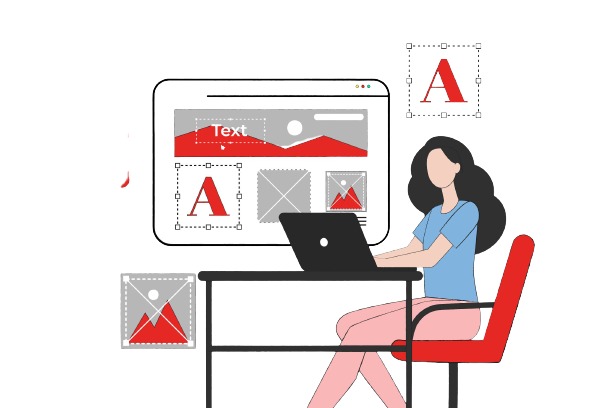
Habits are the compound interest of self-improvement and creative success. You must build good habits and break bad ones to be successful in the creator economy.
- Writers who have built large audiences have a writing habit
- Musicians who have become the best in the world practice
Habits are the reason changing your behavior leads to better outcomes than setting goals.
- First, you can control your habits.
- Second, habits lead to skill, which leads to proficiency and eventually leads to mastery.
- Third, personal transformation is the result of building good habits and breaking bad ones.
If you want to build an audience, become a creature of habit.
3. Design Rituals
"In order to channel your ability to focus-and-perspire-for extended periods of time, you will likely need to develop a consistent work schedule. Structuring time spent executing ideas is a best practice of admiring creative leaders across industries. It is the only way to keep up with the continuous stream of Action Steps and allocate sufficient time for deep thought," says Scott Belsky in his book Making Ideas Happen.
Contrary to popular belief, great creative work never results from divine inspiration. It's the result of rituals, routine, and discipline.
First, Uncertainty is inevitable when you're doing creative work, and having a ritual gives you what Jonathan Fields calls a certainty anchor. A ritual is something you can rely on, regardless of the situation or circumstances.
Second, rituals free you up to focus on doing your work instead of planning it.
Third, ritualizing creative work frees you from the pressure of having to create something brilliant every day. If the work you did sucks today, it doesn't matter because you know you'll be back tomorrow.
4. Develop Your Creative Practice
A practice implies engagement in a ritual. A practice may be defined as the dedicated, daily exercise of commitment, will, and focused intention aimed, on one level, at the achievement of mastery in a field but, on a loftier level, intended to produce communion with a power greater than ourselves-call it whatever you like: God, mind, soul, Self, the Muse, the superconscious.
Steven Pressfield
A creative practice is vital for mastering your craft, making progress with your work, and maximizing your output. Steven Pressfield says that a practice has three key elements.
1. A Time
Not all hours of the day are created equal. The law of diminishing returns sets in at a certain point, and the same effort doesn't yield the same output.
For example, writing in the morning takes less than an hour to write 1000 words, and later in the day, both quality and quantity decline. Determine when you're at your best and plan your creative practice accordingly.
2. A Space
Where you do your work is just as important as when you do it. It's hard to do your best work in a space that makes you feel like shit or makes it difficult to focus.
You need to think of it as a sacred space for making art. If you repeat the same behavior in the same space day after day, you'll start to associate the space with your practice.
3. An Intention
An intention is a deliberate decision to do something in your creative space. The moment you walk into your space, your intention should be some variation of "I'm not here to fuck around. I intend to write 1000 words, cover the canvas, etc. Your intention should be concrete and inspire action.
5. Focus on Mastery Instead of Metrics
Obsessively checking your metrics is a waste of time. Refreshing your google analytics every hour doesn't cause traffic or your audience's size to increase, and creating something worth consuming does.
Leading vs. Lagging Indicators
Leading indicators are metrics you control, and lagging indicators metrics you don't. For a writer, leading indicators might include:
- Daily word count.
- Hours of deep work.
- The number of articles they publish in a month.
Metrics like traffic, subscribers, downloads are lagging indicators.
Lagging indicators are the result of leading indicators. When you start a blog, podcast, youtube channel, or any other creative project, leading indicators should be your priority.
When you measure progress with metrics you can't control, it kills your motivation, and you get discouraged and are more likely to give up. Measuring progress with metrics you control leads to a virtuous cycle of progress, motivation, and creative momentum.
Focus on mastery instead of metrics, and you'll be leaps and bounds ahead of all the morons who get caught up in social media vanity metrics.
Are you too busy to read the whole guide right now?
No worries. Just click on the link below and I'll send you a PDF version, which you can read at your convenience.
Deep Work
To produce at your peak level, you need to work for extended periods with full concentration on a single task free from distraction. Put another way, the type of work that optimizes your performance is deep work. -Cal Newport, Deep Work
Attention is the currency of achievement, and social media platforms have made billions by selling yours to advertisers. It's also one of your most valuable assets when it comes to developing good work habits.
Dopamine is the Brain's Primary Reward Chemical. But, Not all dopamine is created equal. You can get a dopamine burst from an hour of deep work, checking your email, or getting a "like" on social media.
Nobody has ever changed the world by checking and responding to email. And nobody has ever written the great American Status update
Whether you want to write a book, build a business, or have a blog that people read, one focused hour a day of deep work will do more for you than posting pictures on Instagram or writing social media updates on Facebook or Twitter.
Beware the advice of online marketers who tell you to be on every social media platform if you're serious about building an audience.
If you add up how much you read in a year on the internet-tweets, Facebook posts, lists-you've read the equivalent of a shit ton of books, but in fact you've read no books in a year.
Trevor Noah
According to Cal Newport, there are three key questions you must address to develop a deep work habit
- Where you'll work and for how long.
- How you'll work once you start to work
- How you'll support your work
I designed the daily routine that helped me write 4 books and 100 articles and produce over 1000 episodes to support my deep work habit.
![Illustrations for Ultimate Guide to Building an Audience [36855]-12](https://unmistakablecreative.com/wp-content/uploads/2021/10/Illustrations-for-Ultimate-Guide-to-Building-an-Audience-36855-12-scaled.jpg)
The Economic ROI of Deep vs Shallow Work
Aspiring creators who are building an audience overvalue the importance of a large social following and undervalue the role of deep work. But the numbers tell a different story.
The ROI of Composing Tweets, Writing Articles, and Publishing Books
EVERYTHING you do on social platforms fails the deep work test. It's not cognitively demanding, doesn't push your concentration to its limits, or produce anything of substantial long-term value.
Creating something of lasting significance and economic value that leads to personal fulfillment requires a commitment to depth.
$0.00
Assume you have 20,000 followers and share something. In the unlikely event that 5% click on what you share, 1000 people MIGHT consume it. Maybe they share it with their followers and acquire a few more social followers and a few more clicks.
$4800.00
Say you write 2 blog posts a week for a year, and 50 readers a week signup for your newsletter. At the end of the year, you have 2400 subscribers. You launch an online course and sell it for 100 dollars.
If 2% of your readers buy the course, you earn $4800.00
$500,000.00
I self-published two books and two with a traditional publisher. One of the self-published books generated over $30,000 in income and led to a six figure book deal. The book deal led to speaking engagements that paid an average of $5000 for an hour—in the past 5 years, writing books led to more than half a million dollars in personal income.
Even though nobody can guarantee, your books will become successful, the numbers tell a story that make a few things obvious.
- First, it takes a minute to compose a tweet, a few hours to write an article, and a minimum of a year to write a great book.
- Second, it takes more deep work to write an article or book than it does to compose a tweet.
- Third, the more deep work it takes to produce something the more likely you are to create something that leads to a financial reward.
Part 4: How to Build an Audience in the Creator Economy
To build an audience in the creator economy, you must understand the landscape, market dynamics and continually adapt to technological and economic paradigm shifts. But even if you do all of these things, nothing is guaranteed, and anything is possible. That's the harsh truth about a career in the arts that nobody likes to talk about.
1. The Landscape of the Creator Economy
The current creator landscape more closely resembles an economy in which wealth is concentrated at the top. On Patreon, only 2% of creators made the federal minimum wage of $1,160 per month in 2017. On Spotify, artists need 3.5 million streams per year to achieve the annual earnings for a full-time minimum-wage worker of $15,080, a fact that drives most musicians to supplement their earnings with touring and merchandise. Li Jin, The Creator Economy Needs a Middle Class
Low Barriers to Entry Raise the Bar
Even though it's something you can develop through consistent practice, people with talent have an edge that others don't. This isn't the motivational "you can do anything" or "everyone should" insert cultural trend of the moment nonsense that the abundance of bullshit on the internet perpetuates.
With such a low barrier to entry, creators need to honestly assess their skills, strengths, weaknesses, advantages, and disadvantages.
If creators conduct an honest assessment of their skills, they'll be forced to face some unpleasant truths.
- Everybody shouldn't start a podcast or do anything that some influence says "everyone should"
- There's no gold rush, just hard work, and commitment
- You may not "make it" because nothing is guaranteed, and anything is possible.
- Unless you balance what's possible with what's probable, you'll fail.
Lower barriers to entry raise the bar for success in the creator economy. In the words of the economist Tyler Cowen, Average is Over.
Where there's Opportunity, There's Competition.
Anytime opportunity is abundant, competition will be plentiful. In our interview on the Unmistakable Creative, William Dereschwiz shared this harsh truth about the creator economy.
In other words, what you're up against is the entire world. Every podcaster, blogger, Instagram model, and youtube superstar is your competition.
Democratizing Access Doesn't Change the Dynamics of Winner Takes All
"Democratizing entertainment channels and democratizing access to the tools doesn't change the dynamics of winner take all economics. I would much rather have the best person in this space than three people who are okay interviewers. Listening to their podcast is not bringing you the same value as listening to the best interviewer that in that space," says Cal Newport.
We are living in an era of digital inequality in which the winner takes all. The only way around it is to have a bold and compelling point of view, create great content, and have a distribution channel you own to promote that content.
2. Start with Smallest Viable Audience
The most misunderstood idea about building an audience is that you need to reach as many people as possible. Seth Godin, arguably the most well-known blogger on the internet, has a very different perspective.
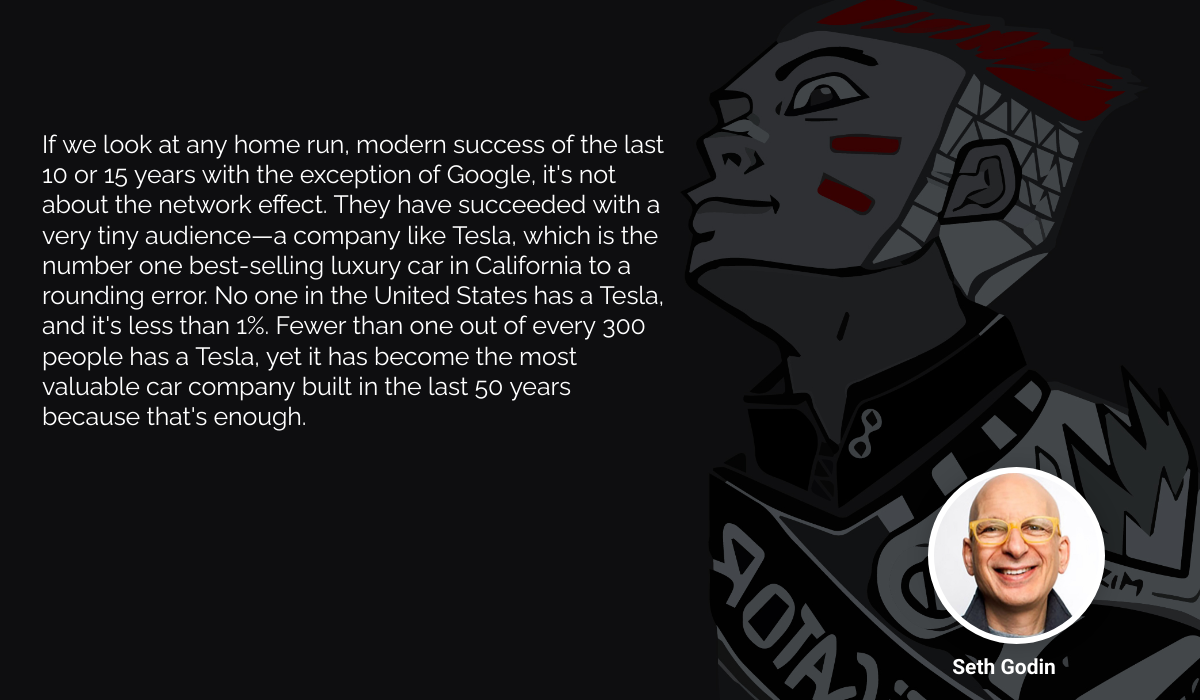
People who own Teslas are not just customers or fans. They're fanatics. Talk to anyone who owns a Tesla, and they will talk your ear off about why it's such a great car.
To build an audience for your content, you have to turn a small army of fans and followers into fanatics and friends for life.
Do Things That Don't Sale
The advice that Paul Graham gives to startup founders applies to creators as well. When you do things that don't scale, it leads to meaningful relationships that last.
- The founders of Airbnb went door-to-door and offered to take professional photos for their first 1000 hosts.
- Chris Guillebeau personally emailed the first 1000 subscribers of his newsletter.
Get to know the people who consume your content and buy your products. When you build a deeper connection with people who consume your content, you stand out from the sea of other emails, podcasts, and blogs in their inbox.
Figure out What Problem You Solve for People
In her book Obsessed: Building a Brand People Love From Day One, author Emily Heyward says Start with The Customer and The Problem You Solve. This is a fundamental question that most people never answer when building an audience for their work.
The paradox of a personal brand is that it's not about you, but the people you serve. Take a look at the list of people below. You can associate a word to describe the problem they solve.
- Ramit Sethi (Money)
- James Clear (Habits)
- Annie Duke (Decision-Making).
- Cal Newport (Attention)
- Lisa Cron (Storytelling)
Even if you've never read their books or consumed any of their content, you know what their work is about. If you don't answer this question, your content will end up in the sea of generic bullshit that's on the internet.
Develop a Bold and Compelling Point of View
Having a point of view is one of the secrets of every successful creator. Your point of view is something you can only discover by figuring out what you stand for. Justine Musk says that if you have a bold and compelling point of view, it will piss people off.
If you need everyone to like you, you'll be screwed.
- Every best-selling book on Amazon has one-star reviews, and every creator on the planet has someone who hates their content.
- Look at any article that has gone viral, and you'll see commenters who hate it.
If this is a problem for you, get over it or find a therapist. When you seek validation from people who hate your work, you waste the time and energy you could have spent creating something for people who love it.
If you stand for nothing and nobody, that's precisely what you'll attract in terms of an audience.
Have an Opinion
Until about 2013, I was hesitant to be opinionated with my writing. My friend Erika Lyermark said, "when I talk to you, you're incredibly opinionated. But that doesn't come through in your work."
The Art of Being Unmistakable, my self-published book that became a WSJ best-seller, was an opinionated rant about the rampant mimicry epidemic on the internet today. And you've heard me on an interview; you might have heard me say, "my publisher could just have easily called my second book Everyone is Full of Shit."
- Whether you love them or hate them, conservative TV and Radio personalities like Glenn Beck, Shawn Hannity, and Bill O'Reilly built massive audiences because they have bold points of view that are compelling to certain people.
- In a recent Medium article, another writer called Umair Haque, the master of catastrophe, but also said this about him: "When you do succumb to the hyperbole of his headlines, you’ll find that his articles so perfectly divide his audience that he gets twice as many reads: those who cheer him and those who loathe him."
If you have a bold and compelling point of view, it's inevitable that someone will hate your work.
Don't be 100% Authentic
There's a fine line between being vulnerable with your content and being a train wreck. When you cross that line, you treat your audience like your therapist. Once you have an audience, you're a public figure, and you need to accordingly.
Danielle Laporte has a simple rule for not crossing the line: she doesn't write about or speak about a challenging experience until she's processed it and healed from it. When she does write about difficult experiences, she doesn't seek pity from her audience but serves them by passing on valuable lessons.
Everyone has problems. But your audience doesn't give a shit about yours. They read your books, listen to your podcast, and watch your videos to help them solve THEIR problems.
If you have a bold and compelling point of view, it's inevitable that someone will hate your work.
3. Three Pillars of Great Content
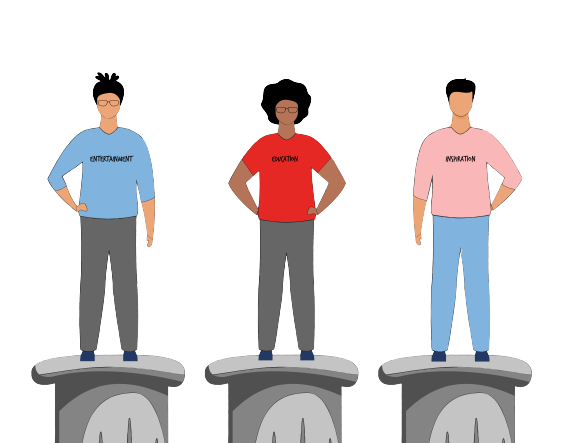
1. Entertainment
In a world where everyone on the internet is suffering from shiny object syndrome, entertainment is vital to getting and keeping someone's attention. The key to entertainment is evoking an emotional response from your audience, resulting from exceptional storytelling.
All of the top 100 podcasts, iTunes, and books on the New York Times Best-Seller list have one thing in common: great storytelling. This is true for both fiction and non-fiction books. As Lisa Cron says, humans are wired for story.
We can't help but pay attention to a story that entertains, captivates, and fascinates us. If people aren't captivated from the moment they press play on a podcast or read the title of your blog post, it's going to be hard to keep someone's attention.
Is Your Content Funny, Interesting, or Thought-Provoking?
If you look at any creator who has managed to build an audience successfully, you'll notice they have one of these three traits in common.
- Janelle Hanchett's fight against helpful parenting advice is a hilarious blog about the experience of raising kids.
- Seth Godin is masterful at creating content that's thought-provoking because he gives people a compass instead of a map.
The easiest way to create something your audience will find interesting is to follow your curiosity. If you are naturally curious about something, it will come through in your content. Curiosity is my number one filter for choosing podcast guests, writing articles, and choosing all of my projects.
2. Education
If people learn something useful they can apply to their life or work, they'll find your content valuable.
- Cal Newport educates his audience about the benefits of deep work and digital minimalism.
- James Clear educates his audience about how to build good habits and break bad ones.
Both of them are best-selling authors who have been incredibly successful with building an audience.
3. Inspiration
Ideally, the content you create inspires action.
Austin Kleon inspires people to steal like an artist.
Chase Jarvis inspires people to express their creativity.
Contrary to popular belief, inspiration isn't always positive. As Tara Mcmullin says, "there's great creative potential in the things that make you angry. If you can inspire, educate and entertain with your content, you'll be leaps and bounds ahead of most people.
Live a Life Worth Writing and Talking About
If there's anything that paradoxically keeps you from creating interesting content, it's reading books, articles and listening to podcasts about how to do it. Go live a life that's interesting to you, and you'll never have a shortage of ideas for interesting content.
Diversify your input, both in terms of the content you consume and the experiences you have.
Are you too busy to read the whole guide right now?
No worries. Just click on the link below and I'll send you a PDF version, which you can read at your convenience.
Marketing, Promotion, and Distribution
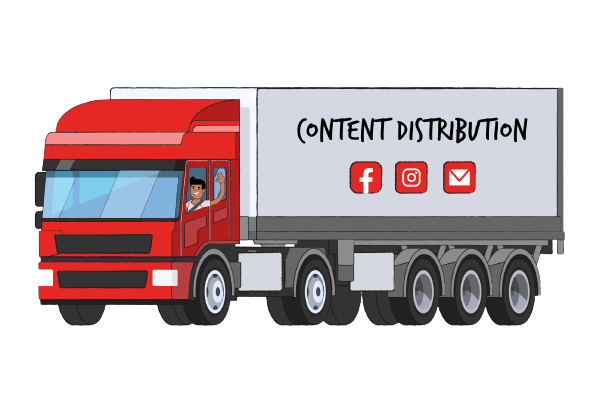
When it comes to marketing, there's no better marketing strategy than creating great content. If your content sucks, SEO and social media won't do a thing to help you build an audience. No matter how hard you try, you can't hide shitty content behind great marketing.
Distribution is The Foundation of Growing an Audience
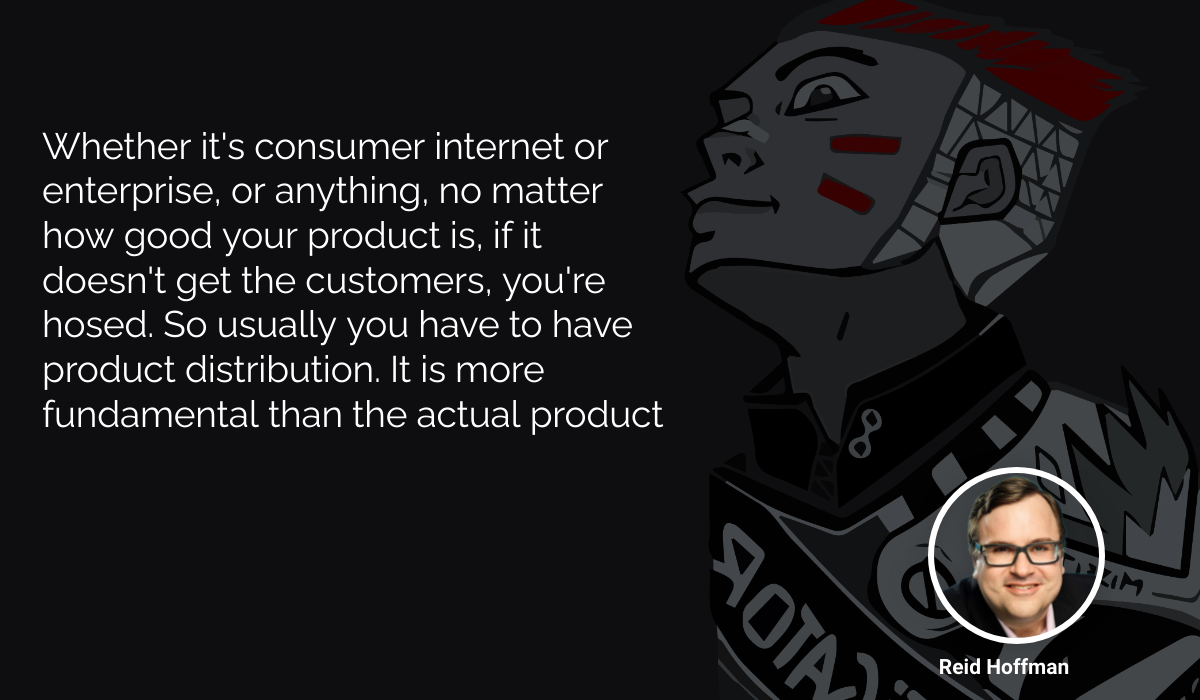
Without a distribution channel for your product, you're screwed. If there's now way to tell people about what you've created, nobody will know about it. This is true whether you're building an audience or trying to scale a startup.
The Overlooked Danger of Social Media: Distribution Channels You Rent
Facebook, Twitter, Instagram, Youtube, Medium, and every other social platform is one you rent with your time, money, or attention. Even if you have a massive social presence, you're building your empire on rented land. All of them democratize access for creators, but they also enslave the creators to their platforms because they don't give them access to their audience's data.
Algorithms Drive Consumption on Social Platforms
My roommate Matt had a few friends with six-figure coaching businesses who were utterly dependent on Facebook to get new clients, and Facebook changed its algorithm, and most of these coaches saw their revenue tank.
Because algorithms drive consumption on most creator platforms, social media is not a viable long-term strategy for building an audience. If someone else owns the distribution channel, THEY decide who sees your content. To put it bluntly, if Facebook is what fuels the growth of your business, Mark Zuckerberg is your landlord.
You're Building Someone Else's Business, Not Your Own
A few weeks ago, a writer on medium published an article titled Why Linkedin is a Waste of Time for Creatives. This quote below summarizes that point I'm trying to make.
As an artist or writer, you are creating free content on social media. Without you, these platforms would die. Is the return worth it?
In Linkedin's defense, they recently launched a creative accelerator to invest in people who create content on their platform. But the harsh truth about the creator economy is that most companies have built their massive empires on the backs of the creators who produce content for their platforms.
Distribution Channels You Own
When I started Unmistakable Creative as a podcast for bloggers in 2009, almost every person I interviewed said the same thing about their biggest mistake: they wish they had started building an email list sooner.
Email vs Social by the Numbers
If I send my latest blog post to my newsletter, which has 9000 subscribers, 400-500 people might click. But if I post the same article on my Facebook page, which has over 7000 fans, 2-3 people might click
When Atomic Habits was available to pre-order, James Clear sent one email letting people know, and 6000 people bought the book. It was virtually guaranteed to become an NYtimes best-seller. Ramit Sethi has said that building an email list sooner probably cost him millions of dollars.
My friend Gareth Pronovost has a Youtube channel with thousands of subscribers. But the service he provides solves a particular problem, and he was able to generate $10000 from a course launch from an email list of 200 people.
To sum it all up, build a distribution channel you own and use the ones you rent to promote assets you own
5. Messaging and Packaging
The adage that people don't judge a book by its cover is not true, especially on the internet. Packaging matters because it's the first impression people have of your work. If you want to stand out in a sea of noise, you must pay attention to the packaging.
Don't Brand Yourself as Nina, Goddess, or Guru
According to Wikipedia, "A ninja or shinobi was a covert agent or mercenary in feudal Japan. The functions of a ninja included espionage, deception, and surprise attacks", not a social media expert.
A goddess or guru is someone you worship. Thats' great if you want to start a cult or perpetuate a bunch of new-age bullshit. But if you're going to build an audience that finds value in your work, you might want to reconsider. If I see the words ninja, goddess, or guru in a pitch from a podcast guest, I delete it.
Packaging Can Be the Difference Between Obscurity and Fame
Unmistakable Creative guest Jim Bunch packaged a concept as the 9 environments that make up your life. Anyone who has heard our interview with him has said it'd been a game-changer for them—the idea resonated with many people.
But a professional organizer who became a best-selling author had the same idea with better packaging. She called it The Life-Changing Magic of Tidying Up. Marie Kondo has sold millions of books, had a show on Netflix, and developed a partnership with The Container Store.
Marie Kondo is much more well-known than Jim Bunch because she shared the same message with better packaging.
People who achieve emotional resonance and get their word to spread aren't always doing something unique. They're sharing the same message as other people with better packaging.
There's a difference between creating hype and creating bullshit. If you want to build an audience, do the former. And if you need some help, read this list of 25 words that make your content seem bland and useless.
Mimicry is Not Modeling
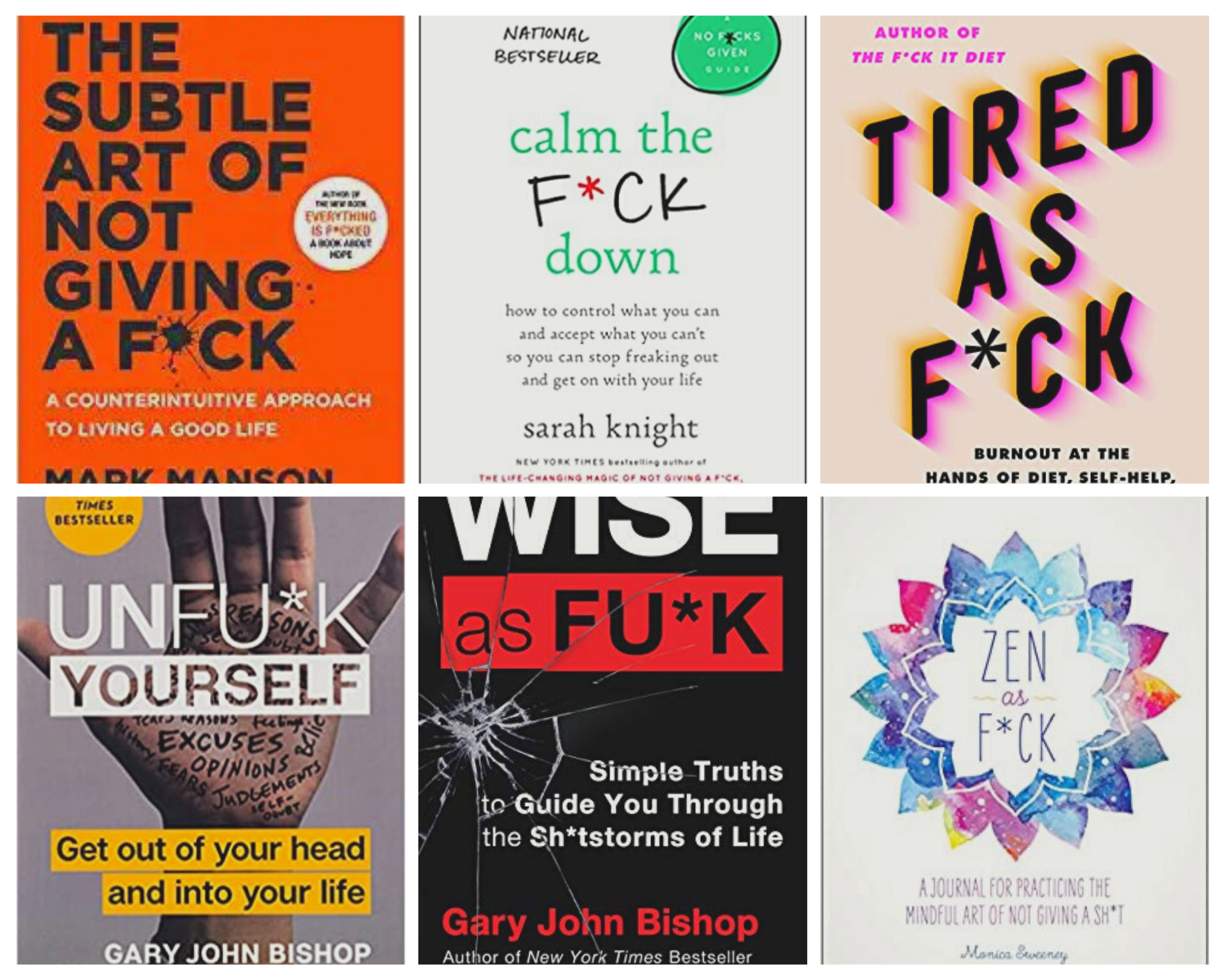
The image above exemplifies the rampant mimicry epidemic that has polluted the minds of authors and publishers.
While the title of Mark Manson's book was provocative, it's ONE variable that played a role in his success. He had a popular blog, a big audience, and is a phenomenal writer.
- He had a popular blog and a big audience
- He is also a phenomenal writer.
Putting "fuck" in the title of your book will not make you a best-selling author. Don't confuse causation with correlation. Steal like an artist, mix other people's ingredients and create your own recipes.
6. The 3 stage Lifecycle of Content Promotion On Distribution Channels
There are three stages to the content promotion lifecycle, but many creators only focus on the first.
1. Awareness
Awareness is the first stage in the lifecycle of content promotion. When you publish a blog post, youtube video or podcast, and share it on social media, you make people aware of your content.
But awareness is not enough to make an idea spread. If it were, all you'd have to do is share a link on social media and call it a day.
2. Interest
Interest is the second stage in the lifecycle of content promotion. There are varying levels of interest.
- If someone likes, hearts, or retweets something, it's a low level of interest.
- When someone clicks on a link, you generate a higher level of interest.
The biggest challenge with generating interest is that social media is that it's a sea of noise. It's why the third stage in the lifecycle of content promotion is vital to growing an audience.
3. Commitment
The third stage of content promotion, like the cycle, is commitment. Like there are with interest, there are levels of commitment
- If someone clicks a link, reads the first paragraph of an article, or listens to the first few minutes of a podcast, that's a low level of commitment.
- If they read the entire article or listen to a whole episode of your show but don't subscribe, that's a medium level of commitment.
When they subscribe to your newsletter, it's a high level of commitment. And if they buy something you sell, it's the highest level of commitment.
Without commitment, there's no retention. You can generate all the awareness and interest you want, but it won't make a difference. Businesses stay profitable, and audiences grow because of retention.
How do you generate commitment? Create something worthy of it. How do you do that? Spend years busting your ass, mastering your craft, and sign up for a journey where nothing is guaranteed, and anything is possible.
7. Adapt to Economic and Technological Paradigm Shifts
![Illustrations for Ultimate Guide to Building an Audience [36855]-17](https://unmistakablecreative.com/wp-content/uploads/2021/10/Illustrations-for-Ultimate-Guide-to-Building-an-Audience-36855-17-scaled.jpg)
In the early '90s, two men living in Los Angeles thought there wasn't any good porn on the internet.
To deal with their dilemma, they developed a way to process credit card payments on the internet for people who wanted better porn. Watch the movie Middlemen if you want to know the rest of the story.
A couple of thousand miles away, a graduate student in the computer science department a the University of Illinois was working on a project called Mosaic. That project eventually became what you probably know as Netscape.
The intersection of the commercial web browser and the ability to process credit card payments on the internet gave birth to e-commerce as we know it.
In the mid to late '90s, it took hundreds of hours, thousands of dollars or specialized knowledge to do something as simple as building a website. Today anybody reading this could create a functional website in a fraction of the time it took me the write this article for less than 10 dollars.
The convergence of new technologies creates paradigm shifts making things possible that weren't before. It's also why the internet is flooded with aspiring creators who want to build an audience.
When new creator platforms emerge, many people ask, "how can I use this to grow my audience or reach more people?" But the question they should ask is, what can I create now that I couldn't before?
Building an audience is, always has been, and always will be about creating something that matters for people who care. There are no shortcuts, life hacks, or coaches who can wave a magic wand and build an audience for your work.
As my mentor, Greg, once said, "the best way to earn passive income is to spend years working your ass off." The same is valid for building an audience in 2021 and beyond.
Are you too busy to read the whole guide right now?
No worries. Just click on the link below and I'll send you a PDF version, which you can read at your convenience.
